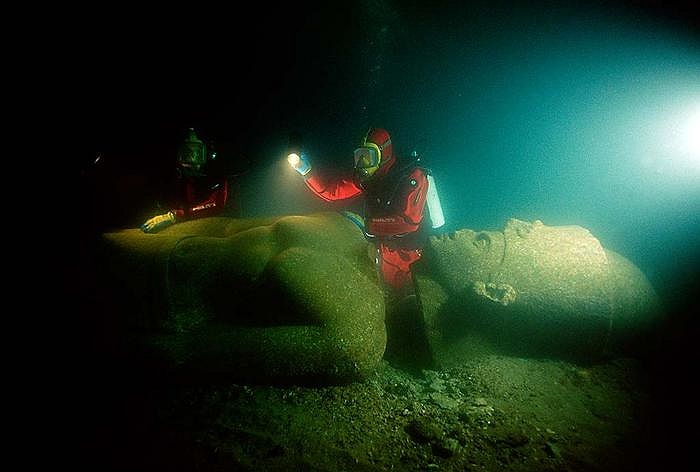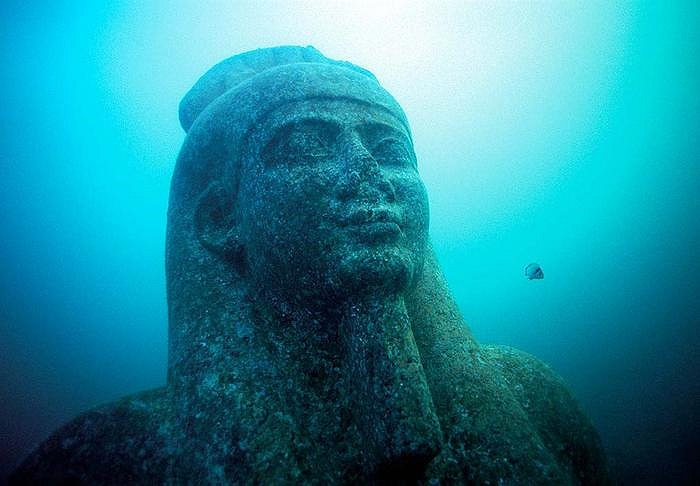A Lost City Rediscovered
In a stunning archaeological triumph, a colossal statue of Hapy, the Egyptian god of the Nile floods, has been lifted from the underwater ruins of the ancient city of Thonis-Heracleion, submerged for over a thousand years beneath the waters of Abu Qir Bay near Alexandria, Egypt. Thonis-Heracleion was once a flourishing hub of commerce and religious activity, but it was devastated by a series of catastrophic earthquakes, tsunamis, and floods that caused it to sink beneath the sea, where it remained hidden for centuries.

The Statue of Hapy: Symbol of Fertility and Power
The statue of Hapy is a remarkable piece of ancient artistry. As the god associated with the annual flooding of the Nile, Hapy symbolized fertility, abundance, and the prosperity that the river’s waters brought to the land. This massive statue, standing at 5.4 meters tall and weighing several tons, is one of the largest known representations of an Egyptian god ever discovered. Its original placement in front of the Temple of Amun-Gereb within the city speaks to the immense reverence that the people of Thonis-Heracleion had for both their deities and the life-giving force of the Nile.
Preservation Beneath the Waves
The city of Thonis-Heracleion was once a vital trading port, connecting Egypt to the broader Mediterranean world. However, the combination of natural disasters led to its sudden submergence and isolation beneath the sea. The unique underwater conditions helped preserve the statue and other relics for over a millennium. When the city was rediscovered by underwater archaeologists, led by the European Institute for Underwater Archaeology, it offered a treasure trove of well-preserved artifacts that have since reshaped our understanding of this lost world.

Insights into Ancient Egyptian Culture
The colossal statue of Hapy is not just an artistic marvel; it also provides key insights into the religious and cultural life of ancient Egypt. The sheer scale of the statue reflects the god’s importance in daily life and religion, particularly in a city dependent on the Nile’s bounty. The recovery of such a monument illustrates the high level of craftsmanship achieved by ancient artisans and underscores the spiritual significance that large-scale statues of deities held in Egyptian society.
Thonis-Heracleion: A Window into a Lost Civilization
The rediscovery of Thonis-Heracleion has been one of the most important underwater archaeological achievements of the modern era. Along with the colossal statue of Hapy, other treasures have been unearthed, including smaller statues, coins, pottery, and the remains of ships that once sailed the busy port. These finds are reshaping historical narratives about the role of the city in ancient trade networks and its influence within the Mediterranean world.

As the ocean slowly gives up its secrets, the statue of Hapy and the treasures of Thonis-Heracleion continue to offer an unprecedented glimpse into the grandeur and complexity of this lost civilization. The discovery serves as a reminder of the fragility of human achievements in the face of nature’s power, as well as the incredible potential for history to be preserved beneath the waves.
Conclusion
The colossal statue of Hapy, raised from the depths of Thonis-Heracleion, stands as a testament to the artistic and cultural heights of ancient Egypt. Its discovery has not only deepened our understanding of Egyptian religious and social life but also demonstrated the significance of underwater archaeology in uncovering the hidden chapters of human history.
